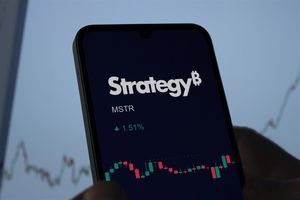Financial News
Inverest Expert Calls XRP and Dogecoin ETFs a Defining Step for Altcoins
 |
London, United Kingdom, Nov 11, 2025, Two new exchange-traded funds are about to open trading in the United States. One tracks XRP, the third-largest cryptocurrency by market value. The other follows Dogecoin, the original memecoin that started as a joke but refuses to fade. Together, these launches hint at a future where digital assets beyond Bitcoin and Ethereum step into the financial mainstream. Peter Kos, a crypto specialist at Inverest, believes this week marks a turning point in the way altcoins are treated by regulated markets.
The timing is striking. In recent months, regulators have shown more flexibility with crypto-linked products. Spot Bitcoin ETFs are already trading in the U.S. Ethereum funds followed not long after. The obvious question is whether altcoins were next in line. The answer, it seems, is yes.
REX and Osprey, the fund issuers, have pushed ahead with new filings. They used a pathway under the Investment Company Act of 1940, a framework designed to protect investors through oversight and disclosure. It is not the route used for spot Bitcoin ETFs, which had to go through the tougher Securities Act of 1933. This 1940 Act structure allows a filing to automatically take effect 75 days after submission unless the Securities and Exchange Commission raises objections. In the case of XRP and Dogecoin, the waiting period has ended without further hurdles.
The REX-Osprey XRP ETF will trade under the ticker XRPR. The fund gives investors direct exposure to XRP, a cryptocurrency tied closely to cross-border payments and remittance use cases. By market capitalization, it ranks just behind Bitcoin and Ethereum, making it the largest altcoin to ever receive such a vehicle.
XRPR is expected to begin trading by Friday.
Will investors line up? That remains to be seen. But if the appetite is anything like what we saw with Bitcoin and Ethereum ETFs, even a modest inflow could lift XRP’s visibility in traditional markets.
If XRPR is serious, DOJE is bold. The REX-Osprey Dogecoin ETF will be the first U.S. fund tied to a memecoin. Its launch is expected on Thursday. Unlike XRPR, the Dogecoin fund does not hold DOGE directly. Instead, it uses a Cayman Islands subsidiary to manage futures contracts. That choice brings extra layers of risk, including roll costs and the usual issues tied to futures-based products.
Still, the very fact that a Dogecoin ETF exists shows how far the crypto market has come. Ten years ago, DOGE was a parody coin. Today, it is about to be wrapped inside a regulated investment vehicle on Wall Street. Some will see that as a sign of progress, others as proof that speculation still dominates the sector. Either way, the milestone is undeniable.
Interestingly, Dogecoin’s price slipped in the days before launch. The token fell around 7 percent to about $0.26, with traders citing liquidations and speculative positioning. Whether the ETF steadies demand or amplifies volatility is a question that will only be answered in the weeks ahead.
This is not the first time REX-Osprey has dipped into altcoins. Back in July, the group launched a Solana staking ETF. That product gathered around $274 million in assets, though inflows slowed in recent weeks. They also filed for a BNB staking ETF in late August. Clearly, the firm is betting that investors want more than just Bitcoin and Ethereum exposure.
At the same time, more than 90 crypto-linked exchange-traded products are waiting for SEC decisions. Among them is a Litecoin ETF from Canary Capital, which could get a final ruling in early October. The lineup hints at a busy few months ahead.
The regulatory context matters here. U.S. officials are not rushing to approve everything at once. Each product goes through its own review. But the pattern is clear. Step by step, more altcoins are moving into regulated wrappers. Each launch makes the next one easier to imagine.
It is easy to get caught up in the headlines. Yet these funds carry real risks. Futures-based structures, like DOJE, expose investors to added costs and tracking issues. Even spot funds, like XRPR, come with liquidity concerns and custody questions. Fees, too, could weigh on returns.
Then there is volatility. Dogecoin, in particular, is known for wild price swings. A regulated ETF does not tame that reality. It only changes the way exposure is packaged. For conservative investors, that is not always enough of a safeguard.
A Defining Moment for Altcoins
Still, one cannot ignore what this week means for the broader crypto space. Until now, only Bitcoin and Ethereum had earned a place in the U.S. ETF market. XRP and Dogecoin are breaking that pattern. Their arrival signals that regulators are willing to stretch the boundaries, even if cautiously.
For Peter Kos, the launches are more than routine filings. They reflect a shift in mindset. Investors who once thought of altcoins as inaccessible or overly speculative now have regulated avenues to consider. Whether they choose to invest is a separate matter, but the access itself changes the landscape.
So, where does this leave the market? If XRPR and DOJE attract significant inflows, other altcoins may soon follow. If they struggle to gain traction, it could temper enthusiasm for future products. Either way, the experiment begins this week.
Disclaimer: This article is purely informational and doesn't offer trading or financial advice. Its content is not intended to be investment advice. We do not guarantee the validity of the information, especially when it pertains to third-party references or hyperlinks.
Copyright (c) 2025 TheNewswire - All rights reserved.
More News
View More




Recent Quotes
View More
Quotes delayed at least 20 minutes.
By accessing this page, you agree to the Privacy Policy and Terms Of Service.



